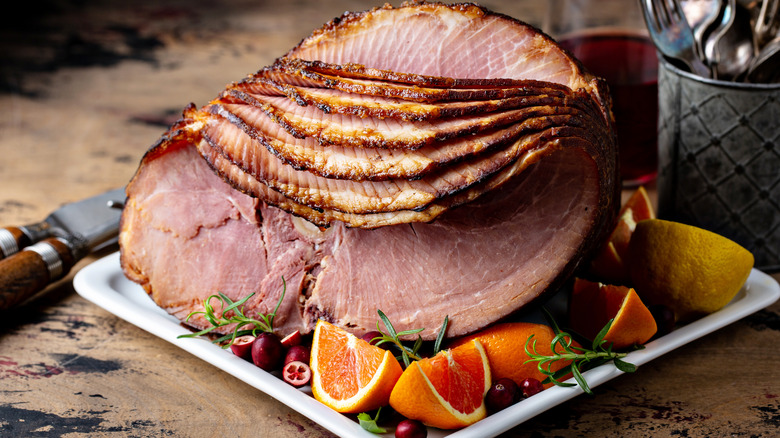The Red Flag Label To Look Out For When Picking Out A Ham
Who doesn't love a savory slice of ham from time to time? This juicy meat is a crowd-pleaser for any special event, whether it's an all-out holiday ham, a cup of cozy ham and bean soup, or some simple leftover ham sandwiches.
Picking out a ham at the grocery store seems easy enough. After all, most hams sold in the U.S. are cured and fully cooked, according to The Ohio State University's College of Food, Agricultural, and Environmental Sciences. This means you only have to warm it in the oven or slow cooker for a few hours before it's ready to serve. Then, brush it with a brown sugar glaze, and you're all set.
While ham is easy to prepare, choosing one at the grocery store may not be. Believe it or not, there are some red flags to look out for when selecting your next store-bought ham. And after learning about how ham is manufactured, you might think twice before putting any old ham into your shopping cart.
What to look out for when picking your next ham
To understand what to look out for when choosing a store-bought ham, it's important to know how hams are manufactured. According to Insider, there are two types of hams commonly found in grocery stores across the U.S.: country hams and city hams. Country hams are dry-cured, aged, and uncooked (think prosciutto), whereas city hams are pre-cooked spiral slices compressed into a tin or round shape. Both types of ham are preserved and cured with various salts, sugars, or chemicals such as nitrates.
City hams are cured in brine (a saltwater bath) for several days. The brine can also be inserted into the ham and then cooked through to give it its pink color. But why is brine added to ham in the first place? Food Network says that brining meat or infusing it with salt not only helps tenderize and moisturize the meat, but it also preserves the meat so that is can stay fresher for longer.
While there are benefits to brining meat, Insider notes that this method can water down the ham's flavor and can give it a spongy texture. Your best bet is to check the labels before buying a ham. If you see "water product" or "water added," you may want to think twice. Instead, look for labels that say "natural juices," which means the ham hasn't been injected with unnecessary brine.
Should you buy city ham or country ham?
You might be left wondering whether you should buy city ham or country ham. The answer is that it depends. As eHow explains, city hams are what you'll find scattered across the dinner table during the holidays because they're fully cooked and only require heating. So long as you watch out for labels like "water added," this ham is your best bet if you're looking for something fast and easy.
Country hams are a bit more complicated because they are dry-cured and aren't fully cooked. This flavorful ham develops a molded exterior over time, giving it a pronounced taste. If you want to wow your guests with flavor, then country ham is the way to go. However, be prepared to spend more time in the kitchen scrubbing, soaking, and boiling it before eating. Smithfield Marketplace states that country hams should be soaked for at least 12-24 hours before cooking, with water changes every 4 hours.
All things considered, this delicious, salty meat can be used for a slew of tasty ham recipes. Before buying your next ham, be sure to read the label to know exactly what you're getting.


